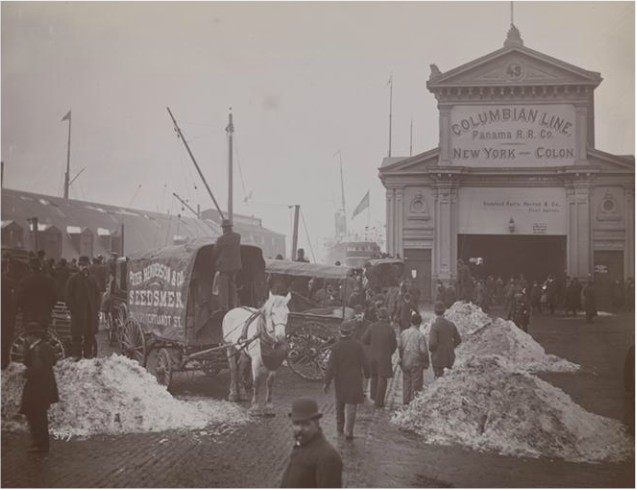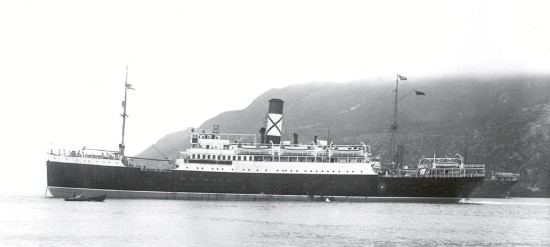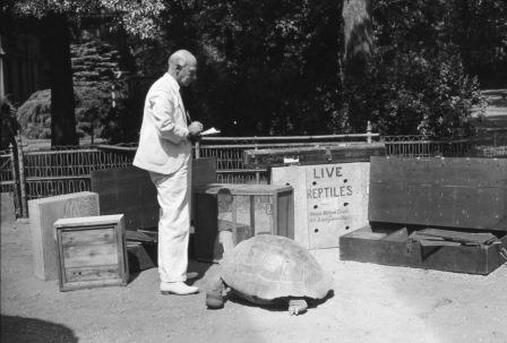Did Raymond Ditmars’s name on the passenger list spell doom for the vessels he sailed aboard during the early and mid twentieth century?
Shipping is integral to the Bushmaster story. It was thanks to the fruit boats steaming up from the tropics to unload their cargo at the many piers of late nineteenth century New York, that the young Raymond Ditmars got up close and personal with exotic South American specimens for the first time. These ‘very pretty tropical reptiles’ as he described the stowaways, included boa constrictors, palm vipers and cat-eyed snakes.
Shipping is integral to the Bushmaster story. It was thanks to the fruit boats steaming up from the tropics to unload their cargo at the many piers of late nineteenth century New York, that the young Raymond Ditmars got up close and personal with exotic South American specimens for the first time. These ‘very pretty tropical reptiles’ as he described the stowaways, included boa constrictors, palm vipers and cat-eyed snakes.
And it was thanks to the British steamship SS Irrawaddy of the Trinidad Shipping and Trading Company, that, in the mid 1890s, the teenage Ditmars first took delivery of a live bushmaster. A serpent which, if legend is to be believed, promptly chased him around his attic room. His parents, sitting two stories downstairs in the large brownstone house on Bathgate Avenue in the Bronx, were oblivious.
At about the same time, Ditmars and the government entomologist John Smith of Rutgers College, travelled down the coast from New York to Jacksonville via Charleston, South Carolina, aboard a Clyde Line ship called Arapahoe. Their mission was to collect insects in the Florida swamps. This, the first of Ditmars’s many ocean voyages, was a thrill.
And of course, during his 40 plus years tenure as a curator at the Bronx Zoo, Ditmars would make many a visit to the New York docks to welcome new shipments.
But did Ditmars unwittingly bestow a curse upon the vessels that brought him such zoological treasures?
But did Ditmars unwittingly bestow a curse upon the vessels that brought him such zoological treasures?
Let’s take the Irawaddy for starters. It’s not clear exactly when R.R. Mole of Port of Spain dispatched to the teenage Ditmars the famous bushmaster (and other snakes), but it must have been sometime in the mid 1890s. And lo and behold, on November 9, 1895, the vessel, during a voyage from Trinidad to New York, with cargo, stranded on the coast of New Jersey through the negligent navigation of her master. According to U.S. Supreme Court report, the vessel was eventually relieved from the strand 11 days later ‘as the result of sacrifices by jettison of a portion of her cargo, of sacrifices and losses voluntarily made or incurred by the shipowners through the master, and through the services of salvors.’
Then, on 11 August 1909, the Arapahoe, mentioned above, broke a shaft and began drifting off the North Carolina coast. Help was summoned via an SOS call, which incidentally, is thought to be pretty much the first time a ship made an SOS call, three years before the Titanic sinking.
To Ditmars’s credit he didn’t seem to have anything to do with that particular disaster. But at least two further boats, aboard which the snakeman made collecting expeditions, came a cropper during the wars of the twentieth century.
The first unfortunate vessel was the Atlantic Transport liner the Minnetonka which Ditmars boarded for Europe on 8 May 1909 taking around 250 specimens of ‘rattlesnakes, copperheads, moccains and other venomous reptiles’ to ‘zoological gardens in London, Paris, and Berlin’ to trade for new ‘specimens for the snake house in the Bronx.’ During the early months of World War One, the Minnetonka made her final trans-Atlantic voyage, becoming in 1915 a military transport. In the ensuing three years she had several close shaves with with German U-Boats bent on her destruction. On January 30, 1918, the her luck ran out while sailing unescorted past Malta. She was sunk by two submarines with the loss of four crew.
The Ditmars hex hit again several decades later. This time it was the SS Nerissa which would come unstuck. This passenger and cargo carrier was a familiar vessel for Ditmars, who sailed on it several times on relaxing Caribbean collecting forays during the 1930s. Alas, the Nerissa was was torpedoed and sunk on 30 April 1941 by German U-boat U-552 following 39 wartime voyages between Canada and Britain. According to Wikipedia she was the only transport carrying Canadian troops to be lost during World War II.
So, did the celebrated snake man have a maritime jinx? It’s a stupid theory but everyone likes pictures of old ships and I needed something to fill a blog post.
Read more amazing stories about the life of Raymond Ditmars in my book Bushmaster: Raymond Ditmars and the Hunt for the World's Largest Viper.
Read more amazing stories about the life of Raymond Ditmars in my book Bushmaster: Raymond Ditmars and the Hunt for the World's Largest Viper.






 RSS Feed
RSS Feed